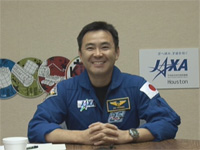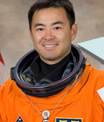JAXA Astronaut Activity Report, November 2009
Last Updated: January 19, 2010
This is JAXA's Japanese astronaut primary activity report for November 2009.
Astronaut Hoshide assigned to ISS Expedition Crew

Astronaut Hoshide at a press conference after the official announcement of his assignment
Astronaut Hoshide has been assigned as an Expedition 32/22 crew member. He is scheduled to stay aboard the ISS for about 6 months from the early summer of 2012.
On Expedition 32/33, Astronaut Hoshide will focus on activities related to space utilization (mainly scientific experiments for Japan and the international partners) during his stay aboard the ISS.
He is scheduled to participate in various training sessions to obtain knowledge and qualifications required to operate the facilities and the science experiments aboard the ISS, as well as training sessions required to operate the Soyuz TMA spacecraft.
Final ISS Expedition Operations Training in Russia

Training related to the Russian module (©FSA)
Expedition 22/23 crew members, including Astronaut Noguchi, who had completed the ISS Expedition operations training at NASA’s Johnson Space Center (JSC), went to Russia along with a backup crew that included Astronaut Furukawa among others. They participated in training on the Soyuz spacecraft and the ISS Russian modules at the Gagarin Cosmonaut Training Centre (GCTC) and S.P.Korolev RSC Energia. This was the last training session prior to their launch.
During training on the Soyuz spacecraft, they simulated how to respond to rapid depressurization inside the Soyuz’s crew cabin, and learned procedures on rendezvous and final approach to the ISS. During a training session on how to manually control Soyuz TMA’s aerodynamic lift force during re-entry and descent phases, they used the centrifugal accelerator to experience the simulated gravitational loads. They also reviewed how to use the iridium satellite telephone they may have to use to contact the mission control center in Moscow in the event they land somewhere far from the scheduled landing site.

Training on amateur radio equipment (©S.P.Korolev RSC Energia)
During training on the Russian module of the ISS, they received an overview of the life support system, as well as how to use maintenance tools, amateur radio equipment, and cameras on board the Russian modules. They also conducted training on science experiments of the European Space Agency (ESA) and Russia.
At the end of the training, they had a 2-day long final examination to evaluate their knowledge and the skills they acquired through training. The examination was conducted using the simulators of the ISS and the Soyuz spacecraft. All Expedition 22/23 crew members, including Astronaut Noguchi, and their backup crew members passed successfully.
Training for the STS-131 mission

Astronaut Yamazaki learning how to set up the camera
Astronaut Yamazaki participated in training for STS-131 at NASA's Johnson Space Center (JSC).
Astronaut Yamazaki, along with other STS-131 mission crew members, used the mock up of the space shuttle to learn how to adjust the centerline camera, which is used during docking to the ISS, as well as cameras mounted on the space shuttle's payload bay, which are used depending on the intensity of the sunlight.
They also participated in simulation training for the operations on Flight Day 3 of the mission. They simulated the operations based on the actual timeline, starting with the wake-up, and ending with the docking to the ISS and hatch opening. Astronaut Hoshide, who will communicate with the STS-131 mission crew members as a CAPCOM, also participated in the training.
They also learned how to operate the cameras on orbit. Astronaut Yamazaki will take pictures and videos as one of her assigned tasks. During the training, she learned how to install the cameras and monitors, the specific shooting procedure for each subject, and the camera angles and the compositions.
Astronaut candidate (ASCAN) training

Astronaut candidate Yui operating a robotic arm on the simulator
Astronaut candidates Mr. Yui, Mr. Onishi, and Mr. Kanai continued the astronaut candidate (ASCAN) training in the U.S., according to the schedule tailored to each candidate.
Mr. Yui participated in training on robotics at NASA's Johnson Space Center (JSC), operating a robotic arm and reviewing what he had learned previously.
Mr. Onishi participated in a training session at JSC on how to operate the Caution and Warning (C&W) system, which alerts the ISS crew members to the dangers of fires and depressurization in the ISS, and practical training to learn how to install and remove the International Standard Payload Rack (ISPR).
Mr. Kanai participated in aircraft flight training at Pensacola Naval Air Station in Florida, United States. After the training session using the flight simulator, he conducted flight training in the rear seat of the aircraft. He also participated in wilderness survival training at the US naval facility in Maine to gain basic knowledge of wilderness survival and to learn how to build a shelter using a parachute.
In addition, Astronaut candidates Mr. Yui, Mr. Onishi, and Mr. Kanai conducted training on the space shuttle at JSC and received the overview of its systems and orbital mechanics.
Astronaut Wakata's mission debriefing

Astronaut Wakata during his mission debriefing
Astronaut Wakata returned temporarily to Japan and visited his alma mater of Kyushu University to hold a debriefing of his ISS Expedition mission.
During the debriefing session Astronaut Wakata showed videos while he explained his ISS Expedition from the launch on STS-119 (15A) to his return on STS-127 (2J/A). He also showed his life in the ISS, Japanese space food, and pictures of Kyushu taken from the ISS.
Concluding the session, where the public audience as well as university students participated, Astronaut Noguchi sent a message to the children in the audience, saying, "I want you to find a goal that you can do your best to achieve, no matter how hard it is. Keep trying to work toward the goal, without giving up even if you fail."







